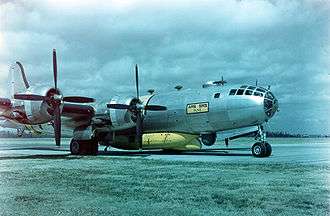A-3 lifeboat

The A-3 lifeboat was an airborne lifeboat developed by the EDO Corporation in 1947 for the United States Air Force (USAF) as a successor to the Higgins Industries A-1 lifeboat. The A-3 lifeboat was a key element of "Dumbo" rescue flights of the 1950s.
Specifications
EDO built the lifeboat of aluminum alloy to be carried by the SB-29 Super Dumbo performing air-sea rescue duties during the Pacific War. Approximately 100 of these lifeboats were built—their serial numbers began at 501 and continued in sequence.
The A-3 lifeboat was 30.05 feet (9.16 m) long and it weighed 2,736 pounds (1,241 kg) when fully loaded and ready for attachment to the aircraft. The A-3 lifeboat could rescue 15 people. It was powered by a four-cylinder four-stroke Meteor 20 gasoline engine made by the Red Wing Motor Company. With an Ailsa Craig propeller it was expected to give a speed of 8 knots (9.2 mph) under calm water conditions. Nearly 100 US gallons (380 L) of fuel were on board. The airborne lifeboat was dropped from the SB-29 on a single 100-foot (30 m) parachute. Like previous airborne lifeboat designs, it was self-righting. The boat had a boarding ladder, and carried food and water for the rescued people.
In March 1951, Time magazine reported that the USAF was testing a radio controlled steering device for the A-3 lifeboat. After the boat dropped into the sea, a radio operator aboard the rescue aircraft would start the lifeboat's engine remotely, then direct the boat toward the survivors to make it easier for them to reach. After climbing aboard, the survivors could talk to the circling aircraft by two-way radio. A gyrocompass aboard the lifeboat would be set toward the nearest safe land, and the supply of fuel would allow for 800 miles (1,300 km) of range, with further range possible if additional water, food and fuel supplies were dropped along the way. The USAF expected all their A-3 lifeboats to be equipped with radio control by early 1952.[1]
World War II and Korean War
Toward the end of World War II, 16 B-29 Superfortress bombers were assigned rescue duty on a rotating basis, a role called "Super Dumbo".[2] Such pared-down B-29s, with reduced armament and added fuel capacity, served in the Pacific War during massed bombing sorties made by regular B-29s. After the war, some 16 of the very heavy bombers were converted to air-sea rescue duties and redesignated SB-29 Super Dumbo. They served in the Korean War,[2] where they were fitted with the EDO airborne lifeboat. A-3 lifeboats were carried by Super Dumbos over the Yellow Sea and the Sea of Japan.
From the beginning of the Korean War, the A-3 lifeboat was kept shackled underneath an SB-29 waiting in constant readiness on the ground at each rescue airbase. However, rainwater could enter the boat and pool inside an open end of the parachute bag. After one air drop which failed because of water that had frozen at high altitude, trapping the parachute, the A-3 lifeboat was stored disconnected from the aircraft and with a rain cover in place.[3]
Later in the Korean War, the USAF worked on improving the A-3 with butterfly fin to stabilize the boat till the parachute opened, a full cover and the ability of the drop aircraft to start the lifeboat's motor and steer it to the location of the persons in the water, and other improvements. Whether any of these improved A-3s were built beyond the prototype and saw active use is unknown. [4]
Survivors
Lifeboat number 603 is under restoration at the National Museum of the USAF.
References
- ↑ Time, March 5, 1951. "Science: Trained Lifeboat." Retrieved on September 21, 2009.
- 1 2 National Museum of the US Air Force. Fact Sheets. Boeing SB-29 Retrieved on September 6, 2009.
- ↑ Marion, Forrest L. "Bombers and boats: SB-17 and SB-29 combat operations in Korea." Air Power History, Volume 51, Spring 2004.
- ↑ "Lifeboat Has Invisible Crew." Popular Mechanics, May 1952, pp. 110-111